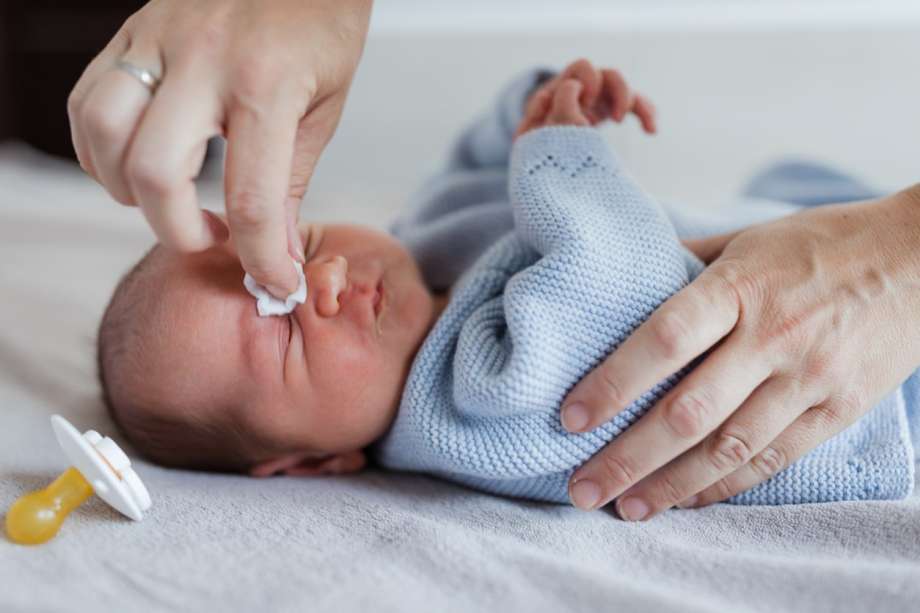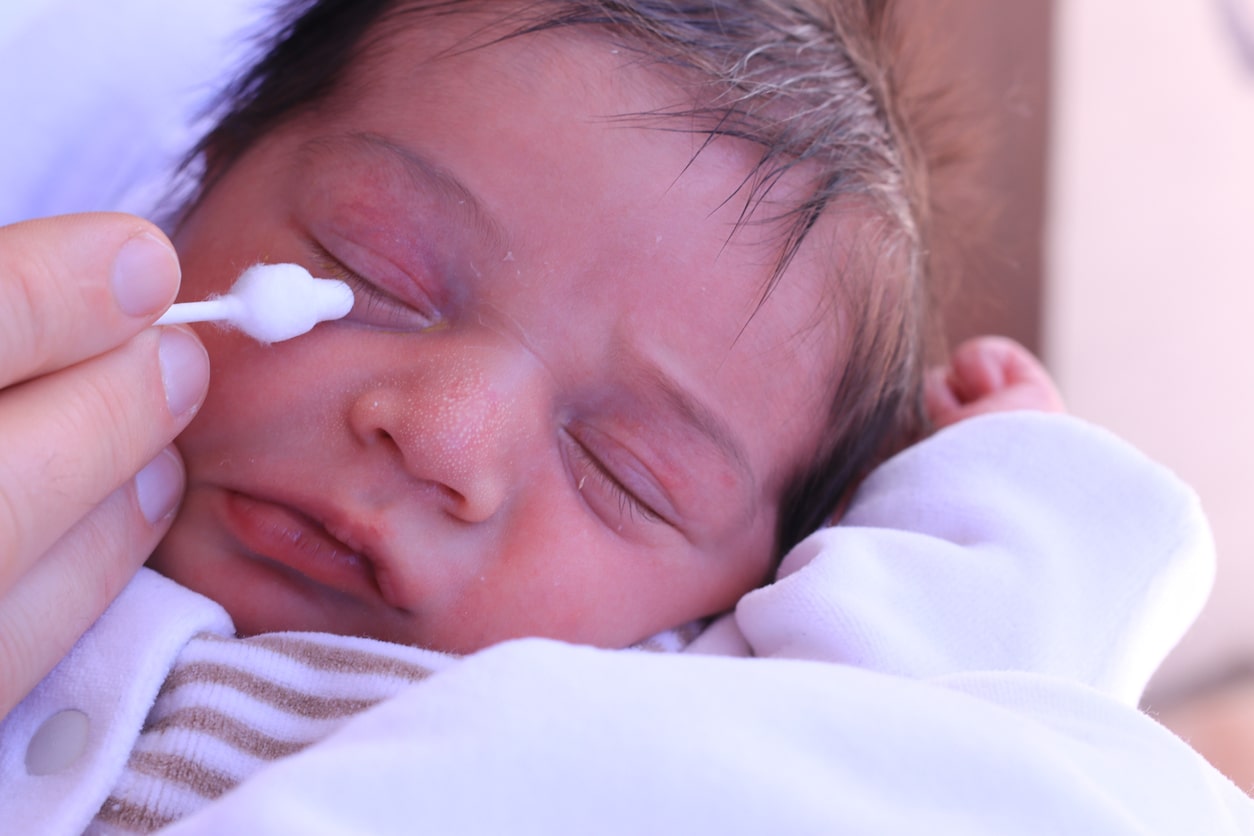Mucus in Baby’s Eyes: Treat Sticky Eye and Discharge

Cleaning and caring for your baby's eyes is incredibly important for their health, especially in the next few weeks. In some cases, eye mucus may just be temporary, but at other times it could indicate a more serious health condition like sticky eye.
If your baby is experiencing eye discharge, mucus buildup, or clogged tear ducts, here’s what you should know.
Related: Eye Health: Protecting Kids Eyes from Harmful UV Rays
What is mucus buildup in an infant’s eye?
Some babies may experience excess tears or mucus buildup in one or both eyes. This condition is called dacrostenosis.
Dacrostenosis can result in watery eyes, eye discharge that can be clear or a bit yellow, or crusting around the eye area (“eye boogers”). This condition is relatively common in newborn babies, with about five percent of babies experiencing this issue.
The most common time to notice this issue starting is when the baby is about two or three weeks old when they begin producing tears. Early symptoms may include noting tears building up in the inner corner of your child’s eyes.
You may also notice tears running down your baby’s face, even when the baby is not crying. About 90% of babies with this condition will have it resolved by one year of age.
What causes mucus buildup in an infant’s eye?
Mucus buildup or a watery eye may occur when the tear duct that normally drains the eye is blocked. The tear duct is also known as the nasolacrimal duct. This blockage can occur during fetal development if the duct develops too narrowly, or if there is a bit of extra tissue in the tear duct.
When a blocked tear duct occurs, the tears that are normally produced to moisturize the eye cannot drain through the duct, and instead build up in the eye. Your baby’s eyes may initially appear watery, but after a few hours, the eye discharge may become thicker and more sticky.
Some babies with a blocked tear duct may have symptoms of a watery eye or sticky eye all of the time, while others may only have symptoms when they are in conditions where the eyes produce more tears, such as when the baby cries, or if they are exposed to cold or windy conditions.
What is “sticky eye”?
Sticky eye can occur when the mucus in your baby’s eyes accumulates so much that the eyelashes on the top and bottom of the eye become stuck together. This is more common after a nap or when waking up in the morning, when a parent or caregiver has not been able to wipe the eye to keep it clear.
It may also be more common if you have been outside and your baby has been exposed to wind, dust, or cold weather, which can irritate the eyes and increase tear production. Other causes of sticky eye can be infection such as pink eye, or an injury to the eye that results in irritation.
These are uncommon causes in young babies, but seeing your pediatrician or healthcare provider for medical advice and a diagnosis is always a good idea. If your child is diagnosed with a blocked tear duct, your healthcare provider will review ways to keep the area clean and lower the infection risk.
How to treat mucus buildup in an infant’s eye

There are a few different ways to help treat and care for watery eyes or mucus buildup in your infant.
Massaging baby’s tear ducts
One way is by massaging the area around the tear duct to try to encourage drainage of this area.
To do this, you can start with clean, dry hands, then gently massage from the corner of your baby’s eye towards their nose. You can also care for your baby’s eyes by using sterile water on a soft cotton wool cloth and wiping the tears or mucus away from the eye area.
Blocked tear ducts will usually go away on their own within your baby’s first year of life. However, some babies will have this eye problem persist and may need to have a procedure done to help unblock the tear duct.
Surgery for blocked tear ducts
Typically this procedure would consist of your pediatrician or other healthcare provider using a small probe to open the blocked tear duct. If this does not fix the eye problem, your pediatrician may recommend seeing a specialist in ophthalmology to discuss surgery to open the tear duct so that it is able to drain.
Usually, if surgery is performed, the problem is permanently fixed and no further treatment is needed.
When to seek medical attention
After your healthcare provider has evaluated your baby and diagnosed it with a blocked tear duct, you will be given instructions on how to care for your baby’s eyes, as listed above. Most babies will not have any medical complications from this problem.
However, having a blocked tear duct may increase the chance that your baby could develop an infection in that eye. If you notice that the conjunctiva (white part) of your baby’s eyes becomes red or inflamed, your baby has swollen eyelids, or the eye starts emitting a green discharge, these could be symptoms of an eye infection.
While websites on the internet may provide some folk remedies for eye infections, such as putting breast milk in the baby’s eye, it is important to call your baby’s healthcare provider for medical advice if you notice signs of an eye infection.
Trying folk remedies at home may give the infection time to worsen and possibly cause more damage. If your pediatrician diagnoses your baby with a bacterial infection, they will review options for treating this. The most common way to treat a bacterial eye infection is with antibiotic eye drops.
Your healthcare provider may diagnose your baby with a viral infection in the eye, rather than a bacterial infection. This may be more likely to occur after your baby has another viral infection, such as a cold or other respiratory infection.
This is commonly known as viral conjunctivitis. Antibiotic eye drops do not treat viral conjunctivitis or other viral infections. In this case, your healthcare provider will recommend other ideas to keep the area clean and help with discomfort, such as saline solution or warm water on a washcloth.
Tips for preventing mucus buildup in the future
Unfortunately, there is no effective way to prevent the watery eyes and mucus buildup that comes along with a blocked tear duct. Because this condition typically resolves without medical treatment, most parents will have to be patient and wait for this condition to improve as the baby grows.
Keeping plenty of clean washcloths and sterilized water or saline solution on hand to keep the area clean is important. Using the massage techniques explained earlier may help the area drain more effectively, or may help the tear duct open more quickly.
Overall, having to deal with watery and crusty eyes in your infant can be bothersome. Seeing crusty goo in your baby’s beautiful eyes isn’t fun! However, this is not typically a dangerous condition and usually goes away on its own.
Follow any medical advice you receive from your child’s healthcare provider, and have lots of patience.

